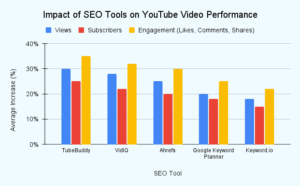Acquiring bulk SEO tools for YouTube success is becoming increasingly important for content creators. With over 2 billion monthly active users, YouTube is the second-largest search engine after Google. As a result, competition among content creators is fierce, and it’s becoming more challenging to get your videos noticed. That’s where SEO tools come in. By using the right tools, you can optimize your YouTube videos for search engines, increase visibility, and ultimately grow your audience.

Bulk SEO tools can help you save time and money. Instead of buying individual tools, you can purchase a bundle of tools that cover all aspects of SEO, including keyword research, video optimization, and competitor analysis. This can be particularly useful if you’re managing multiple YouTube channels or creating videos for clients.
In this article, we’ll explore the benefits of acquiring bulk SEO tools for YouTube success. We’ll discuss the different types of tools available, how they can help you optimize your videos, and what to look for when choosing a tool bundle. Whether you’re a seasoned content creator or just starting, this article will provide you with the knowledge you need to take your YouTube channel to the next level.
Understanding YouTube SEO

YouTube SEO is the process of optimizing video content on YouTube in order to increase visibility, engagement, and watch time. By optimizing your video content, you can improve your chances of ranking higher in YouTube search results and attracting more viewers to your channel.
The Importance of Keywords and Tags
Keywords and tags are crucial components of YouTube SEO. By using relevant keywords and tags in your video titles, descriptions, and tags, you can help YouTube’s algorithm understand what your video is about and make it easier for viewers to find your content.
![]()
It is important to use primary, secondary, and long-tail keywords in your video content. Primary keywords should be used in your video title, while secondary and long-tail keywords should be used in your video description and tags. This will help ensure that your video is optimized for both YouTube search and search trends.
Leveraging YouTube Analytics for Success
YouTube Analytics is a powerful tool that can help you track your video’s performance and optimize your content for success. By analyzing metrics such as watch time, engagement, and audience retention, you can gain valuable insights into what is working and what is not.
It is important to review your YouTube Analytics data regularly to identify trends and areas for improvement. By making data-driven decisions, you can optimize your video content for maximum engagement and watch time.
YouTube Usage and SEO Tool Effectiveness Statistics
| Metric | Value |
| Monthly Active Users | 2.7 billion |
| Daily Hours Watched | 1 billion hours |
| Largest User Base (India) | 467 million users |
| Second Largest User Base (USA) | 246 million users |
| Third Largest User Base (Brazil) | 142 million users |
| Average Length of First-Page Videos | 14 minutes and 50 seconds |
| Percentage of HD Videos on First Page | 68.20% |
| Increase in Sales from Video Marketing | 87% |
| Likelihood to Share Video Content | 51% |
| Annual YouTube Ad Revenue | $31 billion |
| Effectiveness of Multi-Format Campaigns | 57% higher view time |
In conclusion, understanding YouTube SEO is crucial for success on the platform. By optimizing your video content with relevant keywords and tags and leveraging YouTube Analytics to track performance, you can improve your chances of ranking higher in YouTube search results and attracting more viewers to your channel.
Strategic Keyword Research

One of the most important elements of a successful YouTube channel is strategic keyword research. By honing in on the optimal keywords, creators can increase their visibility and attract the right audience. In this section, we will discuss the importance of utilizing keyword research tools and analyzing search volume and competition.
Utilizing Keyword Research Tools
There are several keyword research tools available for YouTube creators. Google Trends is a great optimization tool to start with for getting an idea of what people are searching for. The Google Keyword Planner is another useful tool that provides keyword ideas and search volume data.
Ahrefs Keywords Explorer and Keywordtool.io are also great options for finding long-tail keywords and related keywords.
Analyzing Search Volume and Competition
Once you have a list of potential keywords, it’s important to analyze search volume and competition. This will help you determine which keywords are worth targeting. High search volume keywords are great, but they also come with high competition. It’s important to find a balance between search volume and competition.
![]()
Creators should also pay attention to related keywords and long-tail keywords. These keywords may have lower search volume, but they also have lower competition. By targeting these keywords, creators can attract specific subscribers and increase their chances of success.
In conclusion, strategic keyword research is crucial for YouTube’s success. Creators should utilize keyword research tools and analyze search volume and competition to find the optimal keywords for their channel. By targeting the right keywords, creators can increase their visibility and attract the right audience.
Optimizing Video Content for Visibility
Optimizing video content for visibility is crucial to achieving success on YouTube. This involves crafting compelling titles and descriptions, designing effective thumbnails, and improving video rankings with tags.
Crafting compelling titles and descriptions is vital for video SEO. The title and description should be concise and engaging while also including relevant keywords. The title should be attention-grabbing and provide a clear idea of what the video is about.
The description should provide additional context and information about the video. It should also include relevant keywords and a call to action. It is recommended to keep the description under 200 words and include timestamps for longer videos.
Designing Effective Thumbnails
Thumbnails are the first thing viewers see when browsing videos on YouTube. A visually appealing and relevant thumbnail can significantly increase click-through rates. It is recommended to use high-quality images with bold text and bright colors.
Tools such as Canva, FotoJet, and Snappa offer templates and designs for creating effective thumbnails. It is important to ensure that the thumbnail accurately represents the content of the video.
Improving Video Rankings with Tags

Tags are an essential part of video metadata and can significantly impact video rankings. It is recommended to include relevant keywords and phrases as tags.
Tags should accurately describe the video’s content and be specific. A mix of broad and specific tags is recommended. YouTube recommends using 15-20 tags per video.
Leveraging Bulk SEO Tools for YouTube
Bulk SEO tools are essential for YouTube’s success. They allow creators to optimize their videos for search engines in a time-efficient manner. In this section, we will discuss how to leverage bulk SEO tools for YouTube.

To get bulk SEO tools for YouTube success, you can look at various online platforms that offer tools for YouTube SEO. These platforms usually provide features like keyword research, video analysis, and SEO optimization suggestions. Some popular options include:
- TubeBuddy – Offers video SEO tools that help you find high-performing keywords, optimize your videos, and track your rankings.
- VidIQ – Provides insights into what helps videos perform well, including tags, keywords, and competitive analysis.
- Social Blade – Useful for tracking statistics and growth across various social media platforms, including YouTube.
Bulk Processing with TubeBuddy and VidIQ
TubeBuddy and VidIQ are popular YouTube SEO tools that offer bulk processing capabilities. With these tools, creators can optimize multiple videos at once, saving them time and effort.
TubeBuddy’s bulk processing feature allows creators to update the metadata of multiple videos at once, including titles, descriptions, tags, and more. VidIQ’s bulk processing feature, on the other hand, allows creators to add tags to multiple videos at once.
Both tools also offer bulk thumbnail updating, allowing creators to change the thumbnails of multiple videos at once. This is especially useful for creators who want to update their branding or improve their videos’ click-through rate.

Monitoring Performance with Rank Trackers
Rank trackers are essential for monitoring the performance of YouTube videos. They allow creators to track the rankings of their videos for specific keywords, giving them insight into how their videos are performing in search results.
SE Ranking is a popular rank tracker that offers bulk tracking capabilities. With SE Ranking, creators can track the rankings of multiple videos for multiple keywords at once, saving them time and effort compared to tracking each video individually.
TubeBuddy and VidIQ also offer rank-tracking capabilities. However, these tools are more focused on individual videos rather than bulk tracking.
In conclusion, bulk processing and rank tracking are essential for YouTube’s success. Tools like TubeBuddy, VidIQ, and SE Ranking offer these capabilities, allowing creators to optimize their videos for search engines and monitor their performance efficiently. By leveraging these tools, creators can save time and effort while improving the visibility and performance of their videos on the platform.
Frequently Asked Questions
What are the top SEO tools recommended for improving YouTube video rankings?
There are several SEO tools that can be used to improve the rankings of YouTube videos. Some of the top recommended tools include Keyword Tool, TubeBuddy, VidIQ, and Morningfame. These tools can help with keyword research, competitor analysis, and video optimization.
How can I optimize my YouTube videos for better search engine visibility?
To optimize YouTube videos for better search engine visibility, relevant keywords should be included in the video title, description, and tags. Additionally, the video should have a high-quality thumbnail, engaging content, and a call to action. It is also recommended to share the video on social media and embed it on relevant websites.
Is there a significant impact of SEO on YouTube video performance?
Yes, SEO has a significant impact on YouTube video performance. Proper optimization can lead to higher rankings, increased views, and improved engagement. By using SEO tools and strategies, creators can improve the visibility and discoverability of their videos.
How can I analyze the SEO performance of my YouTube channel?
Creators can use tools like YouTube Analytics, VidIQ, and TubeBuddy to analyze a YouTube channel’s SEO performance. These tools provide insights into video performance, audience engagement, and SEO metrics like keyword rankings and search volume.


